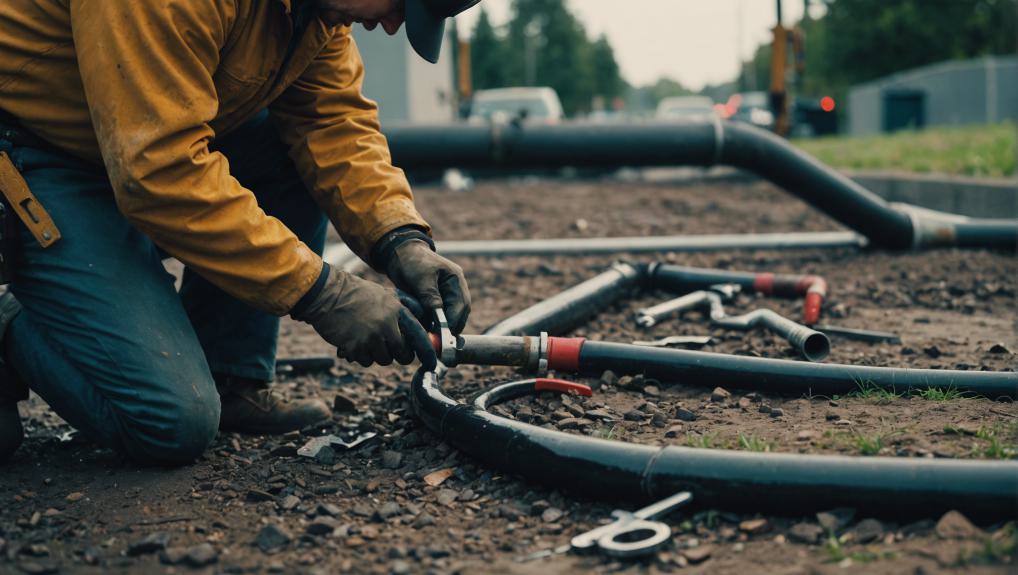To repair your stormwater pipe quickly and easily, identify the damage first. Use high-pressure water jet cleaning for clogs and silicone or rubber sealants for leaks. Apply protective coating for severe corrosion. Deal with tree root damage using root-minimizing chemicals or high-pressure water jet cleaning.
For collapsed pipes, consider trenchless repair methods like slip lining or cured-in-place pipe lining. Choose the right repair techniques based on the specific pipe damage for an effective fix.
Key Takeaways
- Use silicone or rubber sealants for quick and easy fixes.
- Consider pipe camera inspection for accurate damage assessment.
- Opt for trenchless repair methods for faster solutions.
- Try Cured-in-Place Pipe (CIPP) lining for efficient repairs.
- Utilize UV light curing for rapid pipe rehabilitation.
What are the common causes of stormwater pipe damage?
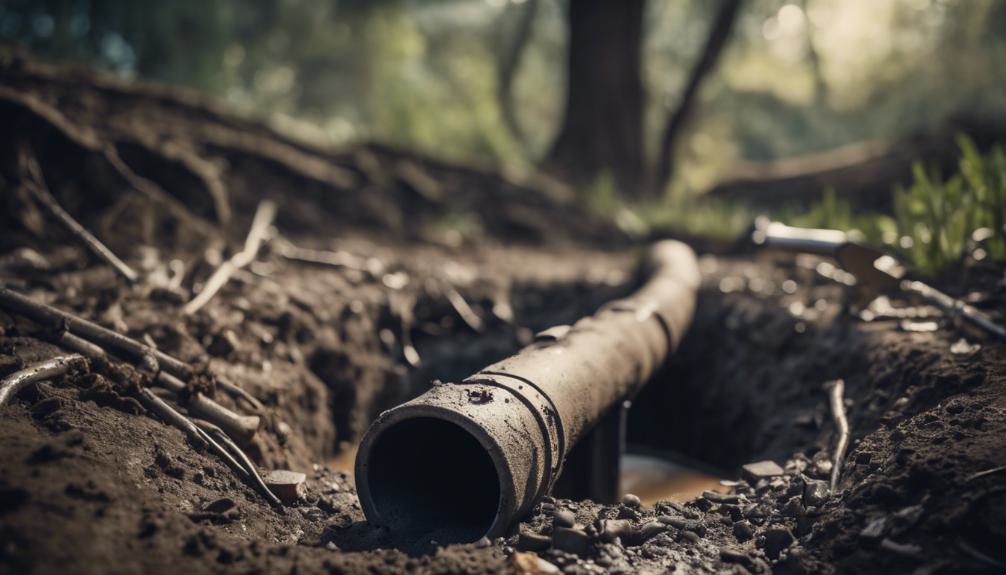
Excessive rain, clogs, collapsed pipes, tree roots, age, external forces, corrosion, and improper installation can all lead to damage in stormwater pipes.
When heavy rain occurs, the increased water flow can overwhelm the pipes, causing stress and potential cracks. Clogs from debris like leaves and dirt obstruct the water flow, leading to pressure buildup and potential pipe damage.
Over time, pipes can deteriorate due to age and corrosion, weakening their structural integrity and making them more susceptible to damage. Tree roots seeking water sources can infiltrate pipes, causing blockages and possible breakages.
External forces such as construction work or shifting soil can also damage stormwater pipes. Improper installation, including incorrect slope or material choice, can result in premature pipe failure.
Understanding these common causes of stormwater pipe damage is essential for effective maintenance and timely repairs to prevent flooding and costly repairs in the future.
How can you identify and locate a damaged stormwater pipe?
When inspecting stormwater pipes for damage, look for signs such as cracks, leaks, or abnormal water flow patterns. Identifying and locating a damaged stormwater pipe is essential to prevent further issues and guarantee effective repairs.
Here’s how you can do it:
- Visual Inspection: Begin by visually examining the pipe for any visible cracks, holes, or signs of wear and tear.
- Water Flow Assessment: Observe the water flow patterns in the pipe. Any irregularities such as slow drainage or pooling water can indicate a blockage or damage.
- Leak Detection: Look for any water leaks around the pipe or wet patches in the surrounding area, as these can point towards a damaged section.
- Use of Detection Tools: Utilize tools like CCTV cameras or smoke testing to inspect hard-to-reach areas and accurately identify the location and extent of the damage.
What are the different methods for repairing stormwater pipes?
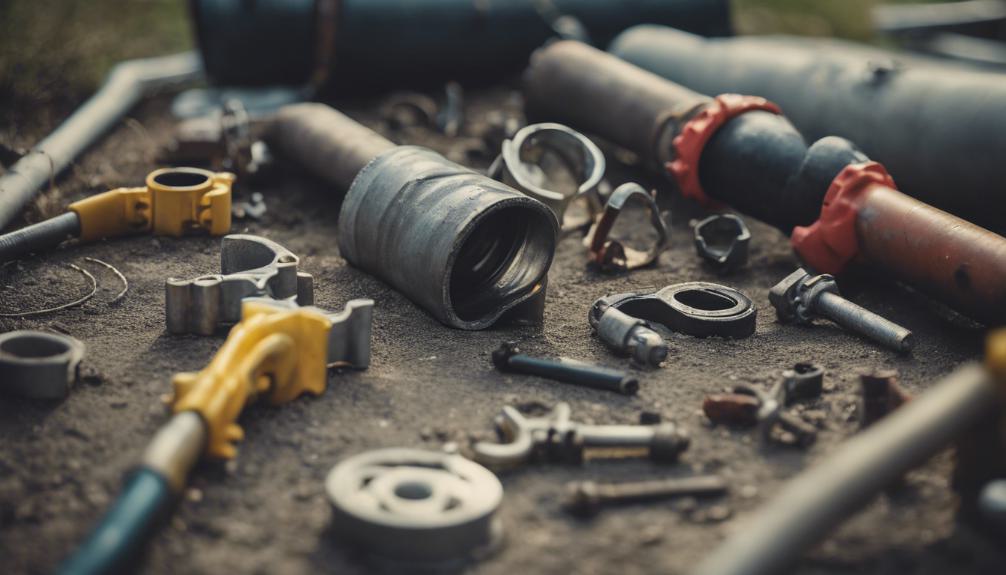
When it comes to repairing stormwater pipes, you have several options at your disposal.
Consider using silicone or rubber sealants for minor leaks, while pipe camera inspection can help pinpoint the exact issue.
More extensive repairs may call for trenchless methods like CIPP lining, utilizing UV light curing for a durable fix.
Silicone or Rubber Sealants
Consider using a silicone or rubber sealant to effectively repair your stormwater pipes. These sealants can provide a quick and efficient solution to leaks or cracks in your pipes. Here are some tips to help you make the most out of using silicone or rubber sealants:
- Prepare the Area: Make sure the damaged area is clean and dry before applying the sealant.
- Apply Evenly: Use a caulking gun to apply the sealant evenly along the crack or leak.
- Allow for Drying Time: Let the sealant cure for the recommended time before exposing it to water.
- Inspect Regularly: Monitor the repaired area for any signs of further leaks or damage.
Pipe Camera Inspection
To explore the various methods for repairing stormwater pipes, start by conducting a pipe camera inspection. This process involves using a specialized camera that’s inserted into the pipe to identify any issues such as cracks, blockages, or leaks.
By visually inspecting the interior of the pipe, you can pinpoint the exact location and extent of the damage. This information is vital in determining the most effective repair method for your stormwater pipe. Pipe camera inspections are quick and efficient, allowing you to diagnose problems accurately without unnecessary digging or disruption.
Once the inspection is complete, you’ll have a clear understanding of the condition of your stormwater pipe and be better equipped to move forward with the necessary repairs.
Trenchless Repair Methods
Wondering what innovative trenchless repair methods are available for fixing stormwater pipes? Here are four effective techniques worth exploring:
- Pipe Bursting: This method involves breaking the old pipe while simultaneously pulling in a new one, minimizing the need for digging.
- Slip Lining: A new pipe is inserted into the existing damaged pipe, reducing the need for excavation and disruption.
- Pipe Relining: Using a resin-coated liner, this method creates a new pipe inside the old one, sealing off any leaks or cracks.
- Spray Lining: A specialized spray-on lining is applied inside the pipe, creating a seamless and durable new layer without the need for excavation.
These trenchless repair methods offer efficient solutions for fixing stormwater pipes with minimal disruption and cost.
Cured-in-Place Pipe (CIPP) Lining
When repairing stormwater pipes, one effective method worth exploring is Cured-in-Place Pipe (CIPP) lining. This method involves inserting a resin-saturated liner into the damaged pipe, which is then inflated and cured in place to create a seamless, jointless pipe within a pipe.
The CIPP lining process typically starts with a thorough inspection to assess the pipe’s condition and size. Next, the liner is impregnated with resin and inserted into the pipe using air pressure or inversion methods. Once in place, the liner is heated or exposed to ultraviolet light to cure the resin, forming a durable new pipe inside the existing one.
CIPP lining is a cost-effective and efficient solution for repairing stormwater pipes with minimal disruption.
UV Light Curing
Considering alternative methods for repairing stormwater pipes, one efficient approach is through UV light curing, which offers a reliable solution for addressing pipe damages. UV light curing involves using ultraviolet light to harden a resin-saturated liner within the damaged pipe, creating a seamless and durable repair.
Here are four key benefits of utilizing UV light curing for stormwater pipe repairs:
- Speed: UV light curing is a fast process, allowing for quick repairs without extended downtime.
- Environmentally Friendly: This method is environmentally friendly as it produces no harmful emissions during the curing process.
- Longevity: The UV-cured liners provide long-lasting repairs that can withstand various weather conditions.
- Minimal Disruption: UV light curing requires minimal excavation, reducing disruptions to surrounding areas.
How do you repair stormwater pipes damaged by tree roots?
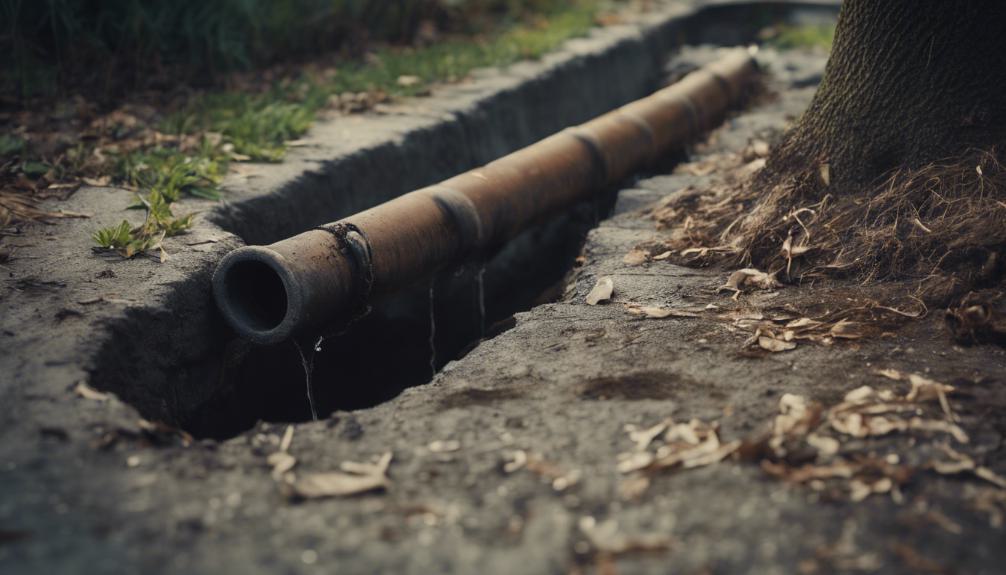
To repair stormwater pipes damaged by tree roots, you can consider using root-minimizing chemicals, high-pressure water jet cleaning, or phytotoxic foam treatment. These methods can help clear out the roots, restore proper water flow, and prevent future root intrusions.
It’s important to choose the method that best suits your situation and address the issue promptly to prevent further damage.
Root-Minimizing Chemicals
Use a root-minimizing chemical to address stormwater pipe damage caused by tree roots. These chemicals can help prevent further root intrusion and protect your pipes.
Here are some tips to effectively use root-minimizing chemicals:
- Choose the Right Chemical: Select a root-minimizing chemical that’s safe for your pipes and effective against tree roots.
- Follow Instructions Carefully: Read and follow the manufacturer’s instructions for the proper application of the chemical.
- Apply Regularly: To maintain effectiveness, apply the root-minimizing chemical at recommended intervals.
- Monitor for Results: Keep an eye on your pipes to make sure the chemical is working and preventing root growth effectively.
High-Pressure Water Jet Cleaning
When addressing stormwater pipe damage caused by tree roots, one effective method for repair is utilizing high-pressure water jet cleaning. This method involves using a specialized nozzle attached to a high-pressure water hose to clear out debris, including tree roots, from the pipe. The nozzle releases water at a high velocity, effectively cutting through blockages and restoring proper water flow.
To repair stormwater pipes damaged by tree roots, start by inserting the nozzle into the pipe and slowly feeding it through while releasing the high-pressure water. Move the nozzle back and forth to cover the entire pipe surface. Once the debris is dislodged, flush the pipe with clean water to remove any remaining residue.
High-pressure water jet cleaning is a quick and efficient solution for addressing tree root damage in stormwater pipes.
Phytotoxic Foam Treatment
Consider applying a phytotoxic foam treatment to effectively repair stormwater pipes damaged by tree roots. This treatment involves using a specialized foam that contains herbicides to kill the roots intruding into the pipes. Here are four steps to help you successfully implement this method:
- Evaluation: Begin by evaluating the extent of root damage in the stormwater pipes to determine the appropriate foam treatment needed.
- Preparation: Clear the pipe of any debris and make sure it’s dry before applying the phytotoxic foam to maximize its effectiveness.
- Application: Follow the manufacturer’s instructions to apply the foam evenly throughout the pipe, ensuring all affected areas are covered.
- Monitoring: Regularly check the treated area to track the progress of root decay and reapply the foam as necessary for complete repair.
What are the solutions for repairing pipes under buildings/structures?
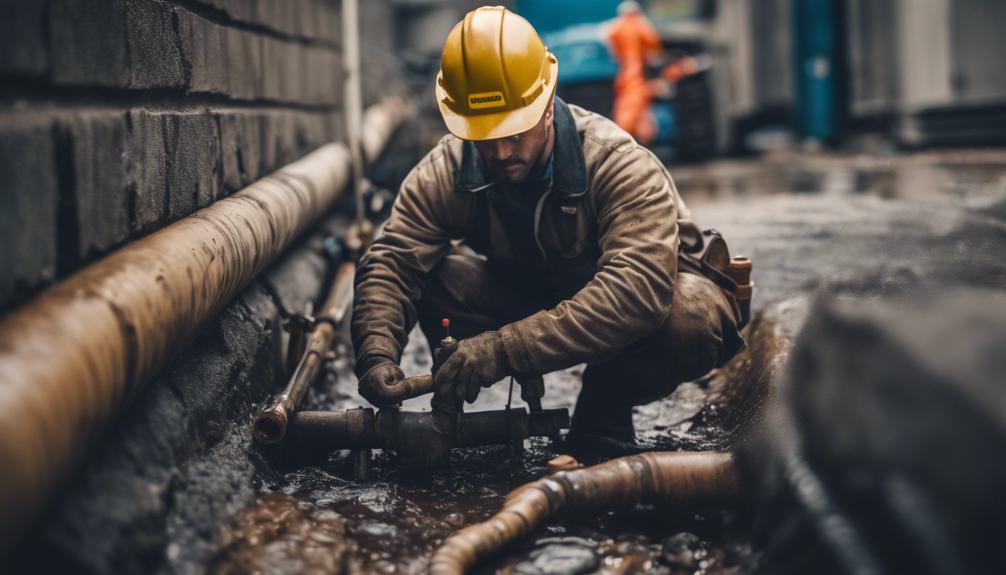
Repairing pipes under buildings or structures demands specialized techniques and equipment to guarantee the structural integrity of the property. When faced with the challenge of repairing pipes located under buildings or structures, there are several solutions available.
One common method is pipe bursting, where a new pipe is pulled through the old one, breaking it apart. This technique eliminates the need for extensive digging and disruption to the building above.
Another option is slip lining, where a new pipe is inserted into the old one, providing added reinforcement and sealing any cracks or leaks.
Additionally, cured-in-place pipe lining involves inserting a resin-saturated liner into the existing pipe, then curing it in place with steam or hot water. These methods are effective for repairing pipes under buildings without causing significant damage to the structure.
It’s important to assess the specific situation carefully and choose the most suitable repair method to ensure the longevity and functionality of the stormwater pipe system.
How can you fix stormwater pipes with severe corrosion damage?
To address severe corrosion damage in stormwater pipes, utilize specialized coatings designed to restore integrity and prevent further deterioration. These coatings act as a protective barrier, extending the lifespan of the pipes and avoiding costly replacements.
Here are four steps to help you fix stormwater pipes with severe corrosion damage:
- Preparation: Clean the pipe thoroughly to remove any debris or rust that could interfere with the coating’s adhesion.
- Application: Apply the specialized coating evenly onto the surface of the pipe using the recommended method, whether it be brushing, spraying, or rolling.
- Curing: Allow the coating to cure for the specified time to guarantee proper bonding and effectiveness.
- Inspection: Once the coating has cured, inspect the pipe for any missed spots or irregularities, and apply additional coats if necessary for complete coverage and protection.
What methods work for repairing pipes in unstable soil conditions?
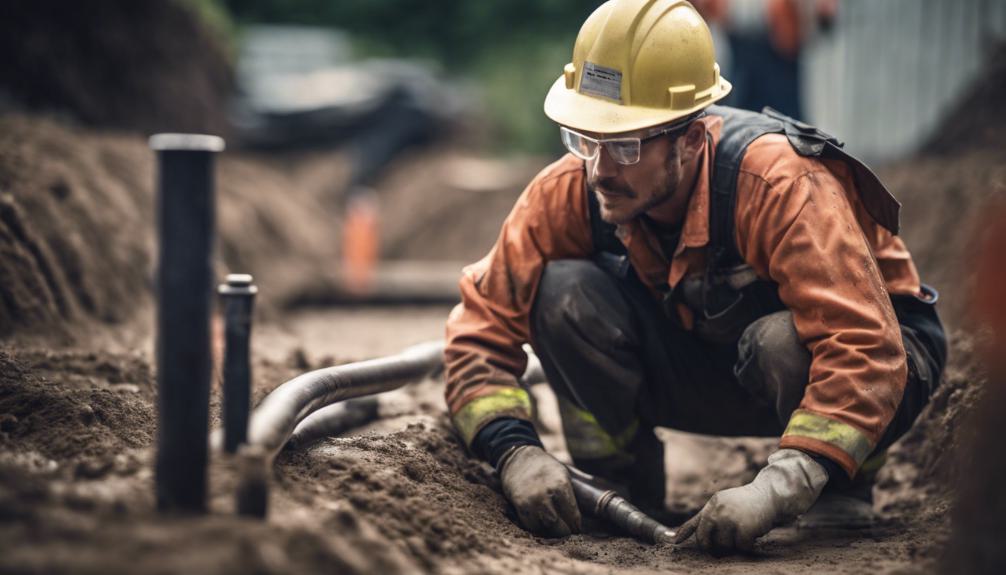
What’re effective methods for repairing pipes in unstable soil conditions?
When dealing with unstable soil, it’s important to choose repair methods that can withstand shifting ground. One effective technique is slip-lining, where a new pipe is inserted into the existing one, providing stability. This method is less invasive and can adapt to soil movements.
Another option is pipe bursting, where the old pipe is fractured and pushed into the surrounding soil as a new pipe is pulled through. This method works well in unstable soils as it helps distribute pressure evenly.
Additionally, using flexible pipe materials like high-density polyethylene (HDPE) can be beneficial in such conditions, as they’re more resistant to ground movements. Ensuring proper compaction around the repaired pipe and using soil stabilizers can also help enhance the stability of the repair.
Are there special techniques for repairing pipes with hazardous materials?
Are there specific safety measures to take into account when repairing pipes with hazardous materials?
When dealing with pipes that contain hazardous substances, it’s important to follow proper protocols to guarantee your safety and the environment’s protection. Here are four essential techniques for repairing pipes with hazardous materials:
- Perform a thorough risk assessment: Before starting any repair work, identify the type and extent of hazardous materials present in the pipes. This assessment will help you determine the appropriate safety measures to implement.
- Use specialized protective gear: When working with hazardous materials, always wear personal protective equipment such as gloves, goggles, respirators, and chemical-resistant clothing to minimize exposure risks.
- Implement containment procedures: To prevent the spread of hazardous substances during pipe repair, establish containment barriers and have spill response kits readily available on-site.
- Dispose of materials properly: After completing the repair, make sure that all hazardous materials removed from the pipes are disposed of according to local regulations to prevent environmental contamination.
Frequently Asked Questions
Can Stormwater Pipe Damage Be Caused by Extreme Weather Conditions?
Yes, extreme weather conditions can cause damage to stormwater pipes. Heavy rain, flooding, and freeze-thaw cycles can weaken pipes, leading to cracks or breaks. Regular inspections and maintenance can help prevent and address these issues before they escalate.
Is It Possible to Detect Stormwater Pipe Damage Without Digging?
You can detect stormwater pipe damage without digging by using innovative technologies like CCTV inspection or acoustic leak detection. These methods allow for non-invasive assessment, saving time and minimizing disruption to your property.
Are There Eco-Friendly Options for Repairing Stormwater Pipes?
You can repair stormwater pipes eco-friendly by using trenchless technology, cured-in-place pipe lining, or pipe bursting methods. These options minimize excavation, reduce environmental impact, and offer efficient solutions for restoring your stormwater system.
How Can You Prevent Future Tree Root Damage to Stormwater Pipes?
To prevent future tree root damage to stormwater pipes, regularly inspect and trim tree roots near the pipes. Consider planting trees away from underground pipes. Implement root barriers and seek professional advice for long-term solutions.
What Should Be Done if a Stormwater Pipe Is Located Under a Building?
If a stormwater pipe is under a building, it’s vital to address the issue promptly. Consult a professional for an assessment and repair plan to avoid structural damage. Swift action can prevent costly complications in the future.
